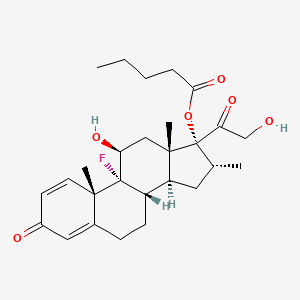D0871 | dexamethasone valerate
| Toxicity | Dose | Time | Species | Model | Method | Action | Positive criterion | Reference |
|---|---|---|---|---|---|---|---|---|
| MEMBRANE POTENTIAL | 12.06±4.39 | human | qHTS-HepG2 | MMP assay | decrease | IC50 | 163 | |
| MEMBRANE POTENTIAL | 17.34 | human | HepG2 | MMP assay | decrease | IC50 | 163 | |
| MEMBRANE POTENTIAL | 23.46±5.67 | rat | hepatocytes | MMP assay | decrease | IC50 | 163 | |
| MEMBRANE POTENTIAL | > 200 µM | 30 mins | mouse | liver mitochondria | Rh123 fluorescence (excitation 485 nm, emission 535 nm) are recorded using a fluorescence multi-well plate reader (mCICCP (20 µM) treatments was considered as the 100% baseline for ΔΨm loss) | decrease | EC20 | 36 |
| RESPIRATION | > 200 µM | 60 mins | mouse | liver mitochondria | Oxygen consumption was monitored with 50nM MitoXpress ( an oxygen-sensitive phosphorescent dye) using a spectrofluorimeter (Tecan Infinite 200; λExcitation 380nm; λEmission 650nm). Rotenone (2µM) was used as 100% baseline for complex I inhibition. | decrease | EC20 | 36 |
| RESPIRATION | > 200 µM | 60 mins | mouse | liver mitochondria | Oxygen consumption was monitored with 50nM MitoXpress ( an oxygen-sensitive phosphorescent dye) using a spectrofluorimeter (Tecan Infinite 200; λExcitation 380nm; λEmission 650nm). Oligomycin A (1µM) was used as 100% baseline for complex II inhibition. | decrease | EC20 | 36 |
| SWELLING | > 200 µM | 30 mins | mouse | liver mitochondria | swelling assay: Absorbance at 545 nm using a fluorescence multi-well plate reader (CaCl2 (50 µM) was considered as the 100% baseline for the swelling ) | increase | EC20 | 36 |
| Target | Dose | Time | Species | Model | Method | Action | Positive criterion | Reference |
|---|---|---|---|---|---|---|---|---|
| NADH:ubiquinone reductase | > 200 µM | 60 mins | mouse | liver mitochondria | Oxygen consumption was monitored with 50nM MitoXpress ( an oxygen-sensitive phosphorescent dye) using a spectrofluorimeter (Tecan Infinite 200; λExcitation 380nm; λEmission 650nm). Rotenone (2µM) was used as 100% baseline for complex I inhibition. | inhibit | EC20 | 36 |
| Succinate dehydrogenase | > 200 µM | 60 mins | mouse | liver mitochondria | Oxygen consumption was monitored with 50nM MitoXpress ( an oxygen-sensitive phosphorescent dye) using a spectrofluorimeter (Tecan Infinite 200; λExcitation 380nm; λEmission 650nm). Oligomycin A (1µM) was used as 100% baseline for complex II inhibition. | inhibit | EC20 | 36 |
| Cytochrome c | > 200 µM | 30 mins | mouse | liver mitochondria | Cytochrome c release was evaluated using ELISA kit ( 20 µg/ml Alamethicin was used as 100% baseline) | release | EC20 | 36 |
| Pictogram | Signal | Statements | Precautionary Statement Codes |
|---|---|---|---|
  |
Warning |
Aggregated GHS information provided by 3 companies from 3 notifications to the ECHA C&L Inventory. Each notification may be associated with multiple companies. H312 (33.33%): Harmful in contact with skin [Warning Acute toxicity, dermal] H361 (66.67%): Suspected of damaging fertility or the unborn child [Warning Reproductive toxicity] H362 (33.33%): May cause harm to breast-fed children [Reproductive toxicity, effects on or via lactation] H373 (33.33%): Causes damage to organs through prolonged or repeated exposure [Warning Specific target organ toxicity, repeated exposure] Information may vary between notifications depending on impurities, additives, and other factors. The percentage value in parenthesis indicates the notified classification ratio from companies that provide hazard codes. Only hazard codes with percentage values above 10% are shown. |
P201, P202, P260, P263, P264, P270, P280, P281, P302+P352, P308+P313, P312, P314, P322, P363, P405, and P501; (The corresponding statement to each P-code can be found at the GHS Classification page.) |
| Organism | Test type | Route | Dose (normalized dose) | Effect | Source |
|---|---|---|---|---|---|
| rabbit | LD50 | subcutaneous | 100mg/kg (100mg/kg) | Iyakuhin Kenkyu. Study of Medical Supplies. Vol. 17, Pg. 1106, 1986. | |
| mouse | LD50 | subcutaneous | 238mg/kg (238mg/kg) | behavioral: muscle weakness | Jitchuken Zenrinsho Kenkyuho. Central Institute for Experimental Animals, Research Reports. Vol. 8, Pg. 23, 1982. |
| rat | LD50 | subcutaneous | 117mg/kg (117mg/kg) | Iyakuhin Kenkyu. Study of Medical Supplies. Vol. 17, Pg. 1106, 1986. | |
| mouse | LD50 | oral | > 3gm/kg (3000mg/kg) | Jitchuken Zenrinsho Kenkyuho. Central Institute for Experimental Animals, Research Reports. Vol. 8, Pg. 23, 1982. | |
| rat | LD50 | oral | > 3gm/kg (3000mg/kg) | Drugs in Japan Vol. -, Pg. 662, 1990. | |
| mouse | LD50 | skin | 1784mg/kg (1784mg/kg) | Jitchuken Zenrinsho Kenkyuho. Central Institute for Experimental Animals, Research Reports. Vol. 8, Pg. 23, 1982. | |
| 33755-46-3 | 9-Fluoro-11?,17,21-trihydroxy-16?-methyl-pregna-1,4-diene-3,20-dione 17-Valerate | 9-Fluoro-11?,21-dihydroxy-16?-methyl-3,20-dioxopregna-1,4-dien-17-yl pentanoate ;DV 17 |
| 9-Fluoro-11beta,17,21-trihydroxy-16alpha-methylpregna-1,4-diene-3,20-dione 17-valerate | 9-fluoro-11ss,17,21-trihydroxy-16a-methylpregna-1,4-diene-3,20-dione 17-valerate | AKOS032429285 |
| Betamethasone Valerate EP Impurity C | Betamethasone Valerate EP Impurity C; | CAS-33755-46-3 |
| CHEBI:135770 | CHEMBL1378167 | D01948 |
| DSSTox_CID_2904 | DSSTox_GSID_22904 | DSSTox_RID_76782 |
| DTXSID3022904 | DV-17 | Dexamethasone 17-valerate |
| Dexamethasone 17-valerate | Dexamethasone Valarate | Dexamethasone valerate |
| Dexamethasone valerate (JAN) | Dexamethasone valerate [JAN] | EINECS 251-669-2 |
| LS-118480 | MCULE-1282205271 | NCGC00159316-02 |
| NCGC00274064-01 | OI7CP949NN | Pregna-1,4-diene-3,20-dione, 9-fluoro-11-beta,17,21-trihydroxy-16-alpha-methyl-, 17-valerate |
| Q27285667 | SCHEMBL124723 | Tox21_111565 |
| Tox21_111565_1 | UNII-OI7CP949NN | Voalla ointment (TN) |
| ZINC3882051 |

